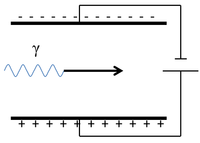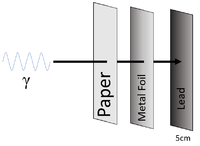Gamma-ray
Contents
Key Stage 4
Meaning
Gamma-rays are a type of ionising radiation emited from the nucleus of an unstable isotope and are the highest frequency and shortest wavelength of electromagnetic wave.
About Gamma-rays as Electromagnetic Waves
- Gamma-rays are transverse waves.
- Gamma-rays can travel through a vacuum as well as through gases in the Earth's atmosphere.
- The speed of gamma-rays through a vacuum is 300,000,000m/s.
As a wave gamma-rays can be:
- Transmitted - Gamma-rays can pass through a medium.
- Absorbed - The energy transferred by gamma-rays can be taken in by certain materials.
- Refracted - Gamma-rays can change direction when they cross the interface between two media.
However, unlike most waves gamma-rays cannot be:
- Reflected - There are no known materials on Earth that can reflect gamma-rays.
Unique Properties
- Gamma-rays are the highest energy electromagnetic waves.
- Gamma-rays are emitted from the atomic nucleus of unstable radioactive isotopes.
- Gamma-rays cause electrons in materials to gain enough energy to leave atoms creating ions which can destroy chemical bonds.
- Gamma-rays are the most penetrating, but least ionising form of Ionising Radiation.
- Gamma-rays can penetrate most materials except for thick lead and thick sheets of other elements more dense than lead on the periodic table.
- Gamma-rays cannot pass through heavy metals (metals with a high atomic mass).
Applications
- Gamma-rays can be used to sterilise food and medical equipment because it causes electrons in materials to gain enough energy to leave atoms creating ions which can destroy chemical bonds in micro-organisms thereby destroying the micro-organism.
- Gamma-rays can be used to irradiate cancerous tumors because they ionise atoms, destroying chemical bonds and can kill the cells. Cancer cells are weaker than healthy cells so more of the cancer cells will be killed than healthy ones.
- Gamma-rays cab be used to trace the flow of fluids through organs because Gamma-rays are emitted from the atomic nucleus of unstable radioactive isotopes which can be injected into a patient and they can penetrate most materials so they leave the body without being reflected, refracted or absorbed by the tissue.
Dangers
- Gamma-rays can cause cancer because gamma-rays can penetrate soft tissue and can ionise and damage DNA molecules in the body cells leading to a mutation.
- High intensity gamma-rays can cause radiation sickness because they can ionise and damage all parts of a biology killing that cell.
About Gamma Rays as Ionising Radiation
- Gamma-rays may also be referred to as gamma radiation and is written with the symbol \(\gamma\).
- Gamma-rays are a the highest frequency electromagnetic wave.
- Gamma-rays have a relative atomic mass of 0 and relative charge of 0.
- Gamma-rays are emitted when a nucleus is has excess vibrational energy after it has decayed via alpha or beta emission.
Charge
| Scientist were able to determine the charge of a \(\gamma\)-ray by sending it between two electrically charged plates and observing its path.
The \(\gamma\)-ray continues in a straight line so it must be neutral. |
Penetration Depth
| Gamma-rays can travel an infinite distance through air and the chances of colliding with an atom or molecule are almost non-existent. |
| Gamma-rays can penetrate paper and sheets of metal foil but cannot penetrate more than a few cm of Lead or a metre of concrete. |
Ionising Potential
- With no electrical charge, \(\gamma\)-rays are the least ionising of the three ionising radiations. It is capable of knocking out one electron from an atom or molecule by being absorbed by an electron in the [[Outer Shell|outer shell].
| When a gamma-ray interacts with an atom the gammarray is absorbed by an electron in the outer shell causing the electron to escape ionising the atom. |
Precautions
- Gamma radiation is the least ionising but most penetrating.
- Gamma-ray sources are kept inside a block of lead with a hole that only allows the gamma-rays out in one direction.
- Outside the body an organism cannot easily be protected from gamma radiation as it can pass through the air unobstructed and needs thick sheets of Lead to block it. Gamma radiation can pass through the skin and ionise tissue deep within the body.
- When handling a source of gamma radiation the precautions which should be taken are:
- Wear gloves - to prevent contamination.
- Use tongs to handle the source, never touch it - to prevent contamination.
- Stand behind a thick sheet of Lead when not using it - to prevent irradiation.
- Aim the source away from any living organism - to prevent irradiation.
- Store the source in a sealed Lead container - to prevent contamination and irradiation.
Equation
\({}_Z^AX \rightarrow {}_Z^AX + {}_0^0\gamma\)
\({}_{42}^{99}Mo \rightarrow {}_{42}^{99}Mo + {}_0^0\gamma\)
Example Calculations
| Find the element 'X' and calculate its relative atomic mass 'A' and its relative atomic charge 'Z'.
\({}_{90}^{231}Th \rightarrow {}_{Z}^{A}X + {}_0^0\gamma\) |
Find the element 'X' and calculate its relative atomic mass 'A' and its relative atomic charge 'Z'.
\({}_{Z}^{A}X \rightarrow {}_{77}^{192}Ir + {}_0^0\gamma\) |
| 1. Calculate the relative atomic mass by looking at the top row of numbers.
231 = A + 0 A = 231 |
1. Calculate the relative atomic mass by looking at the top row of numbers.
A = 192 + 0 A = 192 |
| 2. Calculate the relative atomic charge by looking at the bottom row of numbers.
90 = Z + 0 Z = 90 |
2. Calculate the relative atomic charge by looking at the bottom row of numbers.
Z = 77 + 0 Z = 77 |
| 3. It's the same element.
\({}_{90}^{231}Th\) |
3. It's the same element.
\({}_{77}^{192}Ir\) |
References
AQA
- Gamm rays, page 344, GCSE Combined Science Trilogy 1, Hodder, AQA
- Gamma rays, page 194, GCSE Physics, Hodder, AQA
- Gamma rays, pages 115, 122, 200, 208, 211, GCSE Combined Science Trilogy; Physics, CGP, AQA
- Gamma rays, pages 127, 134, 242, 250, 251, GCSE Physics; The Complete 9-1 Course for AQA, CGP, AQA
- Gamma rays, pages 198, 199, 223, 225, GCSE Combined Science; The Revision Guide, CGP, AQA GCSE Combined Science; The Revision Guide, CGP, AQA
- Gamma rays, pages 261, 266, 268, GCSE Combined Science Trilogy 2, Hodder, AQA
- Gamma rays, pages 44, 45, 76, GCSE Physics; The Revision Guide, CGP, AQA
- Gamma rays; dangers, pages 201, 228, GCSE Combined Science; The Revision Guide, CGP, AQA
- Gamma rays; dangers, pages 47, 48, 81, GCSE Physics; The Revision Guide, CGP, AQA
- Gamma rays; effects on the body, pages 102, 199, GCSE Physics, Hodder, AQA
- Gamma rays; emission during nuclear decay, pages 94, 199, GCSE Physics, Hodder, AQA
- Gamma rays; properties of, page 347, GCSE Combined Science Trilogy 1, Hodder, AQA
- Gamma rays; properties of, pages 96-7, GCSE Physics, Hodder, AQA
- Gamma rays; uses and applications, page 201, GCSE Physics, Hodder, AQA
- Gamma rays; uses, pages 48, 80, GCSE Physics; The Revision Guide, CGP, AQA
- Gamma; ray, pages 109, 115, 124, 126, 197, 213, 216-17, GCSE Physics; Student Book, Collins, AQA
Edexcel
- Gamma rays, page 41, GCSE Biology, Pearson, Edexcel
- Gamma rays, pages 127, 128, 157, 160, GCSE Physics, CGP, Edexcel
- Gamma rays, pages 168, 171, 174, 175, GCSE Combined Science; The Revision Guide, CGP, Edexcel
- Gamma rays, pages 344, 349, 362, GCSE Combined Science, Pearson Edexcel
- Gamma rays, pages 43, 47, 51, 52, GCSE Physics; The Revision Guide, CGP, Edexcel
- Gamma rays, pages 76, 85, 98, GCSE Physics, Pearson Edexcel
- Gamma rays; dangers, pages 136, 165, 166, GCSE Physics, CGP, Edexcel
- Gamma rays; uses, pages 135, 169-171, GCSE Physics, CGP, Edexcel



